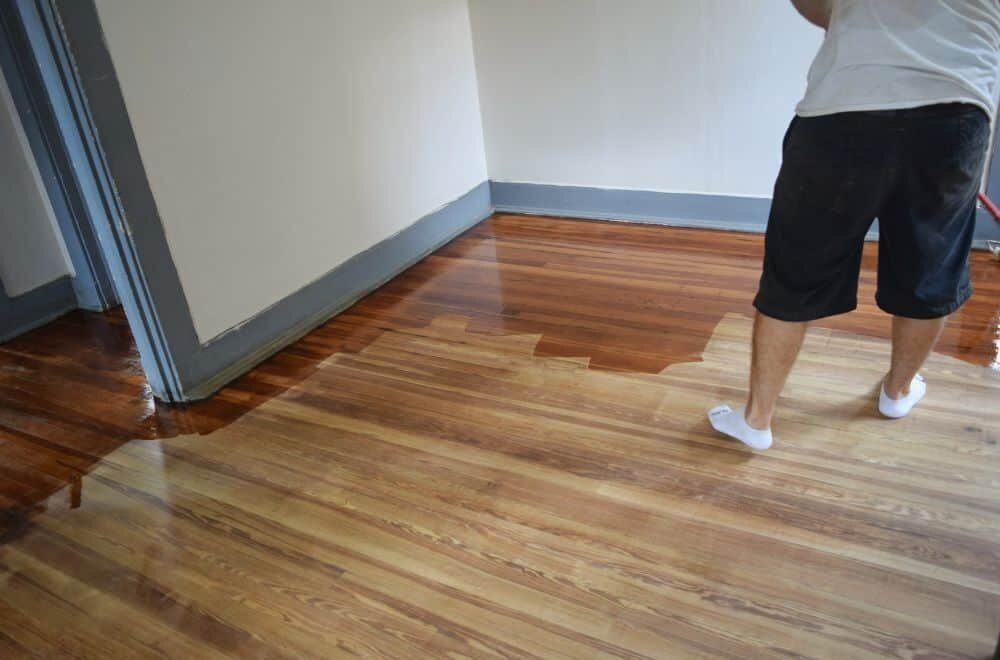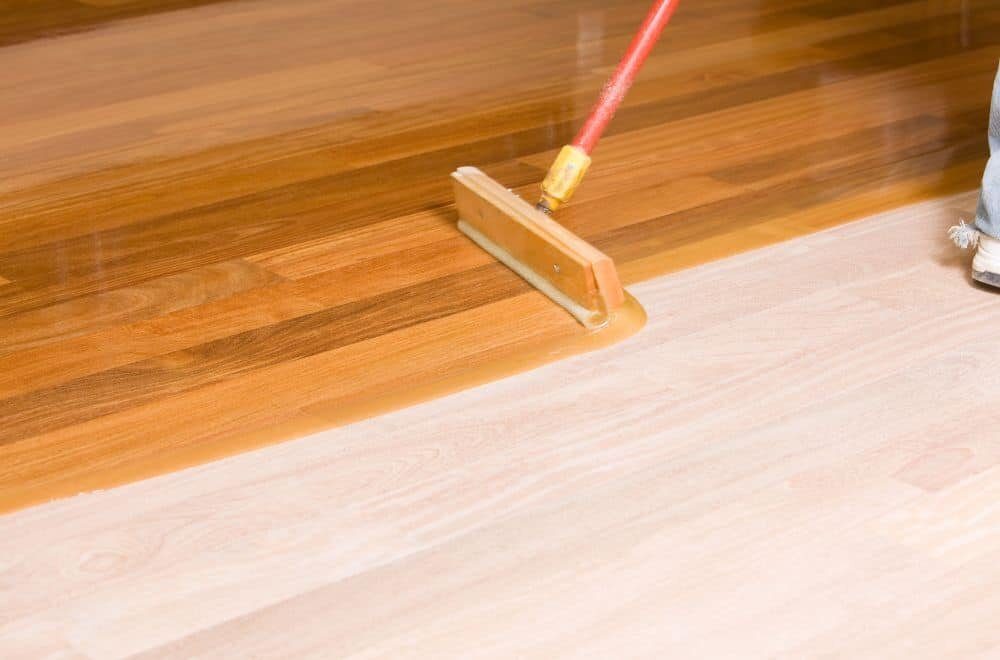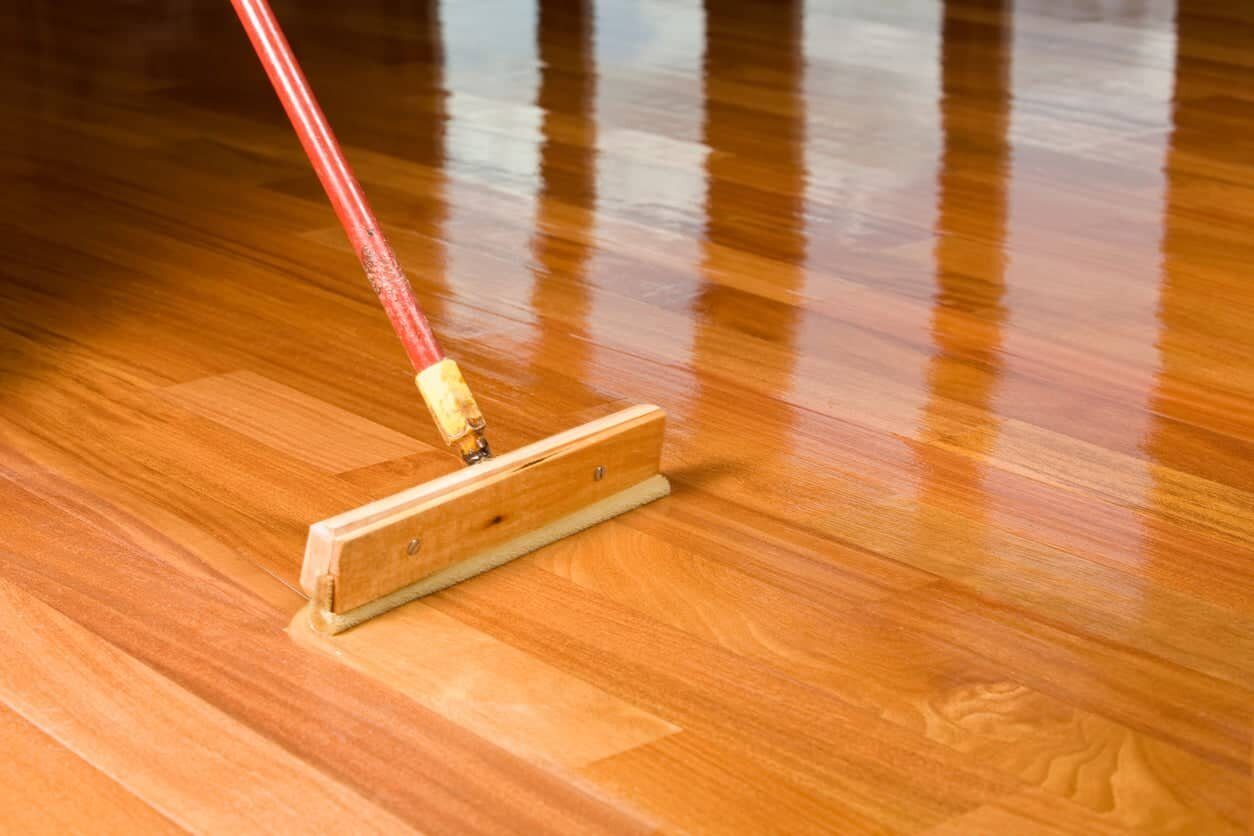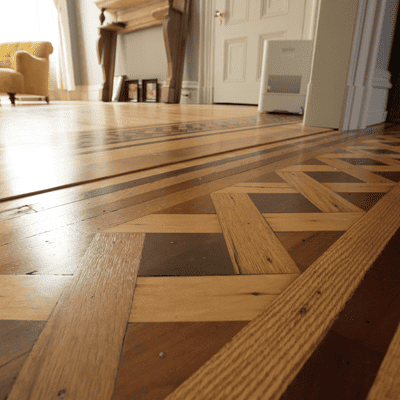Polyurethane is a popular finish for wood furniture and wood floors, and it can help protect the surface of the wood while also giving it an attractive sheen – but it takes some time to apply properly, so this is something you’ll need to consider before using it.
To help you understand the process and the kinds of timescales that are involved – and to give you some advice about which type to choose and how to use it – in this post, we answer the question, how long does it take for polyurethane to dry?
What is polyurethane?

Before we talk about how long polyurethane takes to dry, let’s take a step back and think about what polyurethane is to help us understand what we’re talking about.
Polyurethane is a type of polymer that was first invented in the 1930s and has since been used for a wide range of applications.
For example, many synthetic kitchen sponges are made of polyurethane. It is also found in upholstery and shoes, and it can be used to make plastic straps or bands.
And as mentioned in the introduction, it is commonly used as a protective varnish for wood, both in floors and in furniture.
When used as a finish, it comes in two main forms, oil-based and water-based.
This means that the polyurethane is mixed with either water or oil for application, and after it is applied, the oil or water evaporates, leaving a protective layer of polyurethane on the surface.
Drying vs curing

Now that we understand what polyurethane is, we also need to say a few words about the difference between drying and curing – because they are both vital steps in the application of polyurethane.
After a layer of polyurethane is applied, it will dry relatively quickly. Exactly how long it takes can depend on many factors, something we’ll come to just a moment, but once it is dry, it will no longer feel sticky and will be dry to the touch.
At this point, you can apply another coat of polyurethane if you are working with a piece of furniture, and if you are using it for a floor, it should be safe to walk on it in socks.
However, just because it is dry, it doesn’t mean it’s cured – because to fully cure, it takes a whole lot longer.
The curing process involves the molecules of the polyurethane binding with oxygen from the air. Once this is complete, the layer becomes much harder and more resistant than polyurethane that is just “dry”.
What this all means is that as well as knowing how long it takes for polyurethane to dry, it’s also just as important to know how long it takes to cure – because when curing is complete, it means the whole process of application is finished.
Oil-based vs water-based polyurethane
Although many factors affect how long it takes for polyurethane to dry, one of the most important is whether the polyurethane you’re using is oil-based or water-based – so let’s say a few words about this now.
1. Water-based polyurethane

Since polyurethane dries through the oil or water evaporating off once it’s been applied, water-based polyurethane dries more quickly since the water evaporates off faster and more easily than oil.
It is also practically odorless when compared with oil-based polyurethane, so you won’t need to worry so much about ventilation while you’re applying it.
Once it’s dried and cured, it’s easy to wash with water, and unlike oil-based polyurethane, it doesn’t change color or turn yellow with age.
However, on the downside, it tends to be less durable, so it isn’t a great choice for areas that see lots of foot traffic.
Pros
- Dries more quickly
- Odorless
- Easy to wash
- Doesn’t yellow with age
Cons
- Not as durable as oil-based polyurethane
2. Oil-based polyurethane

Oil-based polyurethane, on the other hand, takes longer to dry after application, so you’ll need to wait longer before you can apply more coats or walk on it. It also has a strong odor, so you’ll have to ensure the area is well-ventilated while you’re applying it.
However, once dry, it is more resistant to everything from heat to water and solvents, and it will also stand up better to heavy foot traffic, so it’s a good choice for wood floors in rooms that see a lot of use.
Unfortunately, another negative to mention is that oil-based polyurethane tends to turn yellow as it ages, so you may need to replace it if you want your floor to remain in perfect condition.
Pros
- More durable than water-based polyurethane
- Easy to clean
Cons
- Takes longer to dry
- Strong odor so needs proper ventilation during application
- Turns yellow with age
Factors that can affect how long polyurethane takes to dry
 Image Credit: bobvila
Image Credit: bobvila
So having talked about what polyurethane is and the different types that exist, now we can say a few words about the other factors that can affect how long it takes for it to dry.
Other than whether polyurethane is oil-based or water-based, here are some of the most important.
Certain types of wood cause polyurethane to dry more slowly than others. For example, polyurethane on woods like cedar takes longer to dry because the oils in the wood don’t absorb the polyurethane as well.
The surface of the wood can also affect how long polyurethane takes to dry. If you apply polyurethane to a live edge or to raw or sanded wood, it will dry more quickly since the wood absorbs some of the polyurethane.
Polyurethane dries more quickly in warmer temperatures than in cold temperatures because the oil or water content evaporates faster. Generally speaking, temperatures above 70°F will cause the polyurethane to dry more quickly.
On the other hand, higher humidity causes polyurethane to dry more slowly for the opposite reason – in more humid conditions, the oil or water in the polyurethane will evaporate more slowly due to the water content in the air.
If the humidity is significantly above 50%, the polyurethane will dry more slowly – but if humidity is significantly below this level, it will dry more quickly.
If the area is well-ventilated with a gentle breeze blowing through, this will cause the polyurethane to dry more quickly since it helps encourage evaporation.
If the surface of the wood is not clean, it will increase the drying time – and will also produce imperfections in the varnish once it’s dry.
So How Long Does It Take for Polyurethane to Dry?
So now we’ve talked about all the various factors that can affect drying and curing times, we can get to the main point of this post and think about how long it takes for polyurethane to dry – as well as how long it takes to cure.
How Long Does It Take for Water-based Polyurethane to Dry
 Image Credit: artisanwoodfloorsllc
Image Credit: artisanwoodfloorsllc
As a rule, water-based polyurethane will be dry after about six hours. This means you can walk on it in socks or apply the next coat.
However, you’re better off waiting a further 24 hours before you walk on it wearing shoes.
After another day – 48 hours after applying the last coat – you can move furniture back onto it, but you shouldn’t place rugs or anything similar on it for at least the first two weeks because this will interfere with the curing process.
Finally, the surface will be fully cured after 30 days.
How Long Does It Take for Oil-based polyurethane to Dry?

If you’re using oil-based polyurethane, you’ll need to wait at least 24 hours before you can walk on it in socks – and you can walk on it in shoes 48 hours after applying the last coat.
Following this, you can move furniture onto it after four days – and rugs can be placed on it after two weeks.
The surface will then be fully cured after 30 days, just like with water-based polyurethane.
Tips
To finish, here are a couple of tips for speeding the process up if you’re short on time.
Use a fast-drying formula if you’re in a hurry
If you’re in a hurry, you can choose a fast-drying formula. These are types of polyurethane that are designed to dry faster than regular formulas. Ask in your local hardware or DIY store when buying it and check the packaging for drying times.
You can speed things up by using a dehumidifier or an A/C unit
Since lower humidity can help with drying times, using an A/C unit or a dehumidifier can also help by reducing the humidity in the air. However, make sure you don’t set the A/C too high – or the lower temperatures will make the polyurethane dry more slowly.
Not an instant solution
As we’ve seen, although water-based polyurethane can be considered dry enough to walk on after just a few hours and oil-based polyurethane takes about a day, the process of fully drying and curing can take quite a bit longer.
This means you need to choose the polyurethane you use for the job carefully – and then you need to plan ahead to make sure you’ll be able to leave the polyurethane to dry and cure correctly to achieve the most perfect results.